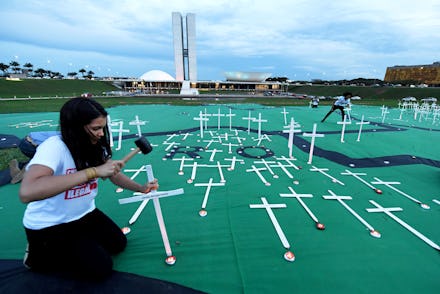2017 was the deadliest year on record for people protecting land from agribusiness

2017 was the deadliest year on record for conservationists trying to protect land from agribusiness, according to a new report from the international nongovernmental organization Global Witness.
A man named Hernán Bedoya died after being shot 14 times by an armed group in Colombia. About 200 people were forced to flee their town in the Philippines after the military killed eight people who were protesting the expansion of a coffee plantation. In the Democratic Republic of Congo, 12 park rangers were murdered, and almost all of their deaths were linked to a group known for illegal poaching and mining.
A total of 207 people were killed in 2017, which translates roughly to four individuals a week. Even worse? That number is “almost certainly a sizable underestimate,” according to the report, because of the “many challenges in identifying and reporting killings.”
Almost 60% of the known victims in 2017 came from Latin America.
Agribusiness, or industrial agriculture, is basically the large-scale farming, manufacturing and distribution of food, often using advanced technology. Agribusiness can pose a number of issues for biodiversity, the environment and people living in the communities targeted for en-masse farming.
For example, more than 5,000 of the 8,688 threatened or near-threatened animal species included in a 2016 study were found to be negatively impacted by agricultural activity. Researchers have also taken issue with agribusiness’ wide usage of pesticides, which are known to be damaging to health and the environment.
And as Global Witness’ report pointed out, people who protest against deforestation or water pollution are being killed by gangs, governments, poachers and others whose wallets might benefit from agribusiness.
Some of the commonly sought goods fueling such violence are palm oil, coffee, fossil fuels, minerals and timber. These materials are sometimes gathered illegally, and militarized private groups intimidate those who protest. Other times, the government is responsible for the violent attacks.
The regions with the highest number of these deaths included Brazil, the Philippines, Colombia, Mexico, the Democratic Republic of Congo and India — all of which experienced at least 11 murders related to protecting lands in 2017.
Fifty-seven people were killed in Brazil and 48 were killed in the Philippines, making them noticeable outliers.
Global Witness called those murdered “land and environmental defenders,” which it defined as “anybody who takes peaceful action, either voluntarily or professionally, to protect environmental or land rights.”
“They are often ordinary people who may well not define themselves as ‘defenders,’” the report read. “Some are indigenous or peasant leaders living in remote mountains or isolated forests, protecting their ancestral lands and traditional livelihoods from mining projects, large-scale agribusiness, hydro-dams and luxury hotels.”
Global Witness’ findings are disturbing, but hardly shocking for conservationists. In 2016, the organization recorded just six fewer murders of land and environmental defenders.
“We urge the powerful institutions and [organizations] that threaten the interests of defenders to use their power to be a force for good,” the NGO stated on its website.